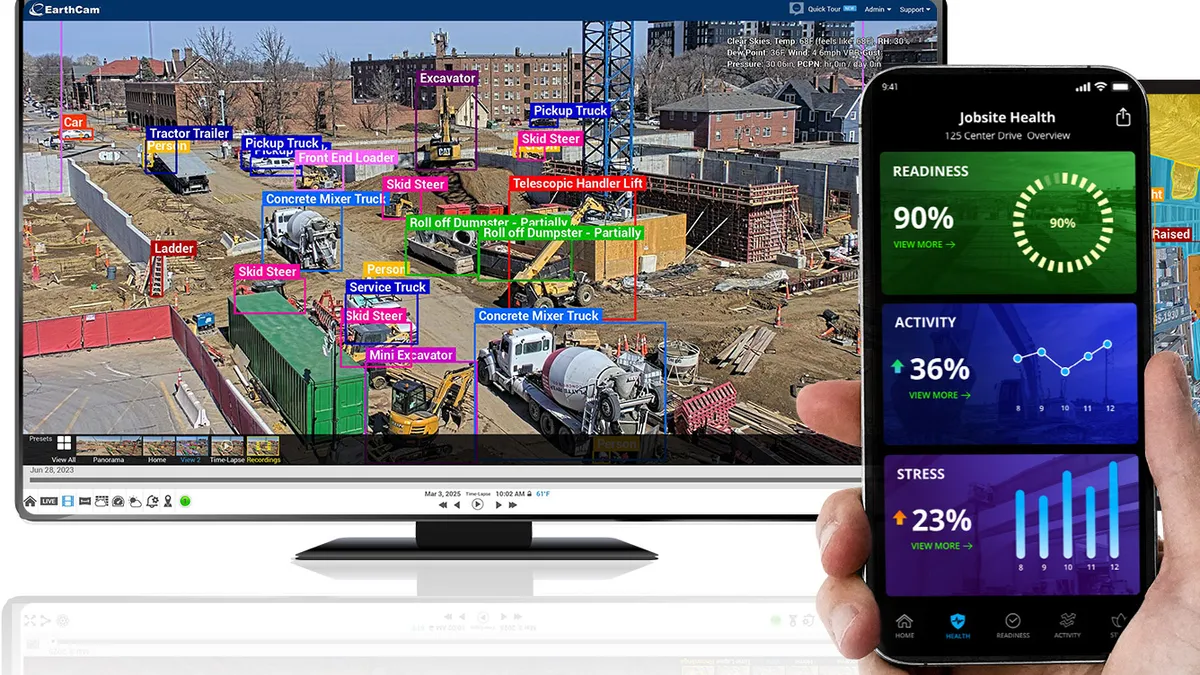It was the pandemic that finally made Prevost Construction's use of data intelligence look really smart.
The Carlsbad, California-based general contractor had already been harvesting budget and planning data from its binders and hard drives manually since 2015. When the pandemic struck, that groundwork let the company quickly adopt a data-first mindset to navigate the initial lockdowns and even grow the business as investment poured into biotech and life science projects.
“When the apocalypse of COVID hit, our aptitude and interest in data collection pointed us to solutions that could manage data to keep operations running,” said Zach Hoffman, Prevost's director of field operations.
In particular, Prevost adopted Safe Site Check In, a smartphone app-driven solution for tracking employee check-in, check-out and movement across different areas within a jobsite. When infections occurred, the company was able to immediately provide data sets for both accountability and contact tracing that allowed projects to stay active when others were shuttered.
“We do a lot of lab construction for large international companies where we’re reporting into a global safety committee,” Hoffman said. “The pandemic created very demanding protocols and we were able to pull real-time reports of where and when our trades were on site. Without that data response to accountability, we would have closed our doors on so many projects, but instead we were able to step up, wow our clients and still reach $97 million in revenue across 2020.”
Prevost isn't alone among contractors leveraging data intelligence in their businesses. Pros say the data is out there in construction, from machine telematics to building materials in motion across the supply chain, staff location tracking, BIM, blueprints, budgets and even more mundane areas like payroll.
For construction companies willing to gain fluency in the language of data intelligence, leveraging the vast amount of info that's already in their systems promises unheralded gains in efficiency, productivity, product quality and jobsite safety.
“We see contractors of all sizes using data to be safer and more profitable and to win more work,” said Matt Abeles, vice president of construction technology and innovation at Associated Builders and Contractors. “Data intelligence allows contractors to make decisions by using real insights that maximize potential for growth and improvement.”
Improved feedback loops
PCL Construction, for example, has created a smart construction platform that aggregates data sets as disparate as material delivery times and locations, real time machine and workforce telemetry, throughput and even jobsite humidity to gain productivity and quality advantages.
“We are leveraging those data sets to build models for our jobsites that can be put into the digital twin and leveraged within a BIM environment,” said Andrew Ahrendt, director of integrated construction services at PCL's U.S. headquarters in Denver.
He said that "feedback loop" today is much faster and continues to improve.
“We think construction, engineering and manufacturing are closely aligned there,” Ahrendt said. “Data and analytics are tools just like a forklift or hammer. Whether it’s simple one-to-one comparisons or very complex models like a digital twin or artificial intelligence or machine learning, the idea is simply to bring data into a format where you can convey plans, strategies and outcomes in order to develop the certainty that you can reach your goals.”
Flattening the learning curve
Still, data intelligence isn’t without its challenges.
Often the sheer size of data sets makes processing inherently dependent on artificial intelligence, machine learning and predictive analytic software and systems. Consider that the latest DCC 2.0 update to the Dodge Construction Network includes more than 3 trillion data elements tracking construction projects, companies, the people at those companies and the products used on construction projects.
“There are more digital tools and construction-related data available in construction than ever before,” said Steve Masters, senior vice president of product management at Dodge. “The challenge now is to leverage the right tools and maximize data to gain the right insights at the right time, to simplify construction's increasing complexity and ensure reliable growth and profitability for all involved.”
Patrick MacLeamy, one of the progenitors of the data science that ultimately led to BIM in the mid 1990s, agrees there are still some upfront hurdles for using data in construction today.
“There is a learning curve for sure," said MacLeamy, chairman of digital workflow firm BuildingSmart International and the former CEO of global architecture and engineering firm HOK. But he sees an AEC industry today that’s vastly different from the one he operated in during the 1970s and 1980s. He credits open BIM standards and other efforts to standardize construction data globally with creating a common language that enables faster, broader adoption of data intelligence disciplines.
"But we’ve already seen incredible advances in vertical construction where the GCs were way ahead in the adoption of BIM, because the complete datasets save time and money, and they are subsequently passing the demand for data intelligence on the jobsite to MEP and other subcontractors,” MacLeamy said.
Bridging the data gap
In fact, the construction industry might now be positioned to help other built-environment sectors better succeed with data intelligence.
MacLeamy said some of the fastest-growing adoption of open BIM standards today can be seen in the road, bridge, tunnel and energy infrastructure sectors. Likewise, PCL is exploring opportunities to evolve BIM-powered smart construction platforms into data intelligent facilities management systems.
“Bridging the gap of data transformation from the engineering environment to the construction environment to the operations and maintenance environment is the next jump,” Ahrendt said. “If we can continue to leverage open APIs and take a master data approach that reduces proprietary and single source data platforms and programs it will only continue to help the industry evolve.”
Dodge’s Masters agrees that the biggest barrier to widespread adoption of data intelligence has been siloed data sets across multiple platforms that required licenses to access even the most basic of information. But that's quickly changing.
“Construction cannot continue without innovation,” Masters said. “The world demands that we change our ways, grow more efficient and evolve. This applies not only to the physical aspects of building, but the inner workings of the overall process.”



















